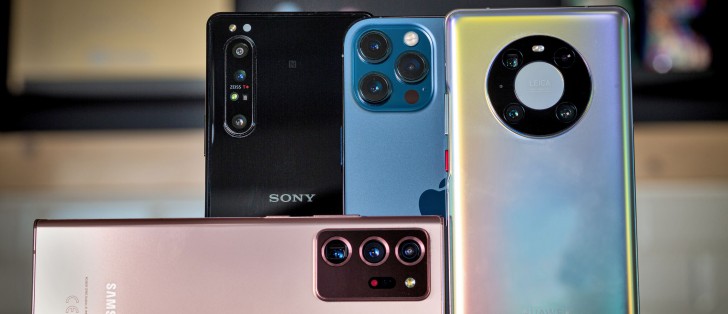Camera test: iPhone 12 Pro Max vs. Mate 40 Pro vs. Xperia 1 II vs. Galaxy Note20 Ultra

Low-light video quality
Up to around dusk, the phones maintain fairly acceptable video quality out of their main cameras. The Xperia gets notably noisier, the iPhone gets particularly soft, and both it and the Mate lose fine detail in the darker areas. We do like the iPhone's dynamic range and colors, though. The Galaxy does the finest job in terms of detail, but it's not great when it comes to color saturation.




Video screengrabs, main camera: Galaxy Note20 Ultra • iPhone 12 Pro Max • Mate 40 Pro • Xperia 1 II
One annoying bit of the Xperia's performance is the flicker caused by the street lights - your mileage will likely vary depending on the solution in your particular area, but it's what we have here. None of the other phones suffered from that.
The ultra wides suffer more badly as light levels drop with the iPhone going very soft, perhaps the only clip here we wouldn't call decent. The Note and the Xperia opt for the detail and noise side of the noise-reduction-vs-detail balance. The Mate's footage is usable too. It's just that we were hoping for more out of it, and the results are hardly enthusiasm-inducing.




Video screengrabs, ultra wide camera: Galaxy Note20 Ultra • iPhone 12 Pro Max • Mate 40 Pro • Xperia 1 II
At 2.5x zoom, the iPhone footage looks positively great under the circumstances. The Xperia tele doesn't cope quite as well, but it was trailing the iPhone in good light, and it's following it here too. The Galaxy footage is usable if you must, while you're better off avoiding the Mate's in-between zoom levels in the dark.




Video screengrabs, 2.5x zoom: Galaxy Note20 Ultra • iPhone 12 Pro Max • Mate 40 Pro • Xperia 1 II
At 5x magnification in challenging light, the iPhone's footage is more of a mush than an actual video, and the Xperia throws in some big blocks of noise to spice up the softness. The Mate's tele doesn't enjoy these conditions one bit either and returns soft footage, combined with a disconcerting focus hunting. The Note20 Ultra, meanwhile, keeps its focus and retains a level of detail the others can only dream of.




Video screengrabs, 5x zoom: Galaxy Note20 Ultra • iPhone 12 Pro Max • Mate 40 Pro • Xperia 1 II
We limited our ultimate low-light test to just the main cameras since experience proved we should lower our expectations. The iPhone maintains the most likable colors and the widest dynamic range, while the Note goes into an orange mode. The Mate is doing quite well on the detail front, but the dynamic range is narrow. The Xperia, meanwhile, fails to gather enough light and produces an underexposed and noisy image.
Video stabilization
Stabilization is available in all modes on these phones, and a couple of them even let you disable it - imagine that - the Galaxy and the Xperia. We decided to keep it on for this next test, however.
All four will successfully stabilize main camera footage captured while walking to a generally similar level of smoothness. The only exception is the Xperia, which does let a few steps make it to the video and can be a little twitchy. We observed no jello-ing on any of these (in 4K30), and panning introduced no weird effects.
Recording while running is obviously more demanding. If you're running on a relatively rough surface and looking at the phone and not your feet, you can expect shaky footage from all these, though the level of stabilization they provide is still better than none.
You'd get much more stable looking footage in such fast-paced conditions by switching to the ultra-wide cameras, which are inherently less prone to shake, plus they deliver that action-cam look. The Galaxy and the iPhone are spectacular for the task, the Mate and the Xperia - notably less so.
Reader comments
- Hossien
- 28 Apr 2023
- cSx
No phone in the world can take pictures as well as a camera, a phone is something that is always available. The camera is not always available, but the phone is everywhere. If a random scene happens, the camera is not available to you, you have to ...
- Anonymous
- 03 May 2022
- fD9
imma tell you what, i know a thing or two about taking photos and i would take a proper camera over this
- Anonymous
- 06 Mar 2022
- Y7I
That's why I have a Sony RX100 VI for trips and outings when I want better pictures than with my phone. I can zoom in optically a lot and it has a nice picture quality. No need for a DSLR unless you are a paid photographer or need it for work or...